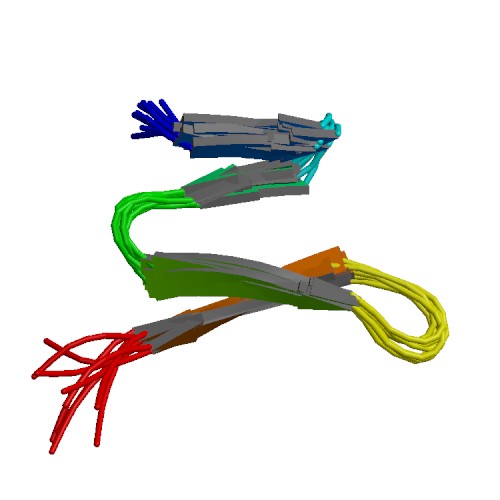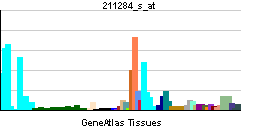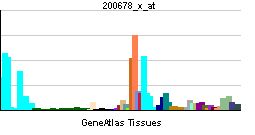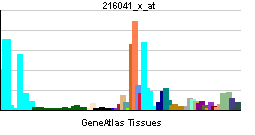Granulin
| Granulin | |||||||||||||
|---|---|---|---|---|---|---|---|---|---|---|---|---|---|
 PDB rendering based on 1g26. | |||||||||||||
| |||||||||||||
| Identifiers | |||||||||||||
| Symbols | GRN ; GEP; GP88; PCDGF; PEPI; PGRN | ||||||||||||
| External IDs | Template:OMIM5 Template:MGI HomoloGene: 1577 | ||||||||||||
| |||||||||||||
| RNA expression pattern | |||||||||||||
 | |||||||||||||
 | |||||||||||||
 | |||||||||||||
| More reference expression data | |||||||||||||
| Orthologs | |||||||||||||
| Template:GNF Ortholog box | |||||||||||||
| Species | Human | Mouse | |||||||||||
| Entrez | n/a | n/a | |||||||||||
| Ensembl | n/a | n/a | |||||||||||
| UniProt | n/a | n/a | |||||||||||
| RefSeq (mRNA) | n/a | n/a | |||||||||||
| RefSeq (protein) | n/a | n/a | |||||||||||
| Location (UCSC) | n/a | n/a | |||||||||||
| PubMed search | n/a | n/a | |||||||||||
Granulin, also known as GRN, is a human gene.[1]
Granulins are a family of secreted, glycosylated peptides that are cleaved from a single precursor protein with 7.5 repeats of a highly conserved 12-cysteine granulin/epithelin motif. The 88 kDa precursor protein, progranulin, is also called proepithelin and PC cell-derived growth factor. Cleavage of the signal peptide produces mature granulin which can be further cleaved into a variety of active, 6 kDa peptides. These smaller cleavage products are named granulin A, granulin B, granulin C, etc. Epithelins 1 and 2 are synonymous with granulins A and B, respectively. Both the peptides and intact granulin protein regulate cell growth. However, different members of the granulin protein family may act as inhibitors, stimulators, or have dual actions on cell growth. Granulin family members are important in normal development, wound healing, and tumorigenesis.[1]
References
Further reading
- Eriksen J, Mackenzie IR (2008). "Progranulin: normal function and role in neurodegeneration". J Neurochem. 104 (2): 287–297. doi:10.1111/j.14714159.2007.04968.x. PMID 117953663 Check
|pmid=value (help). - Serrero G (2003). "Autocrine growth factor revisited: PC-cell-derived growth factor (progranulin), a critical player in breast cancer tumorigenesis". Biochem. Biophys. Res. Commun. 308 (3): 409–13. PMID 12914763.
- Ahmed Z, Mackenzie IR, Hutton ML, Dickson DW (2007). "Progranulin in frontotemporal lobar degeneration and neuroinflammation". Journal of neuroinflammation. 4: 7. doi:10.1186/1742-2094-4-7. PMID 17291356.
- Mackenzie IR (2007). "The neuropathology and clinical phenotype of FTD with progranulin mutations". Acta Neuropathol. 114 (1): 49–54. doi:10.1007/s00401-007-0223-8. PMID 17458552.
- Pickering-Brown SM (2007). "Progranulin and frontotemporal lobar degeneration". Acta Neuropathol. 114 (1): 39–47. doi:10.1007/s00401-007-0241-6. PMID 17572900.
- Bhandari V, Bateman A (1992). "Structure and chromosomal location of the human granulin gene". Biochem. Biophys. Res. Commun. 188 (1): 57–63. PMID 1417868.
- Bhandari V, Palfree RG, Bateman A (1992). "Isolation and sequence of the granulin precursor cDNA from human bone marrow reveals tandem cysteine-rich granulin domains". Proc. Natl. Acad. Sci. U.S.A. 89 (5): 1715–9. PMID 1542665.
- Plowman GD, Green JM, Neubauer MG; et al. (1992). "The epithelin precursor encodes two proteins with opposing activities on epithelial cell growth". J. Biol. Chem. 267 (18): 13073–8. PMID 1618805.
- Bateman A, Belcourt D, Bennett H; et al. (1991). "Granulins, a novel class of peptide from leukocytes". Biochem. Biophys. Res. Commun. 173 (3): 1161–8. PMID 2268320.
- Maruyama K, Sugano S (1994). "Oligo-capping: a simple method to replace the cap structure of eukaryotic mRNAs with oligoribonucleotides". Gene. 138 (1–2): 171–4. PMID 8125298.
- Baba T, Hoff HB, Nemoto H; et al. (1993). "Acrogranin, an acrosomal cysteine-rich glycoprotein, is the precursor of the growth-modulating peptides, granulins, and epithelins, and is expressed in somatic as well as male germ cells". Mol. Reprod. Dev. 34 (3): 233–43. doi:10.1002/mrd.1080340302. PMID 8471244.
- Kardana A, Bagshawe KD, Coles B; et al. (1993). "Characterisation of UGP and its relationship with beta-core fragment". Br. J. Cancer. 67 (4): 686–92. PMID 8471426.
- Zhou J, Gao G, Crabb JW, Serrero G (1993). "Purification of an autocrine growth factor homologous with mouse epithelin precursor from a highly tumorigenic cell line". J. Biol. Chem. 268 (15): 10863–9. PMID 8496151.
- Andersson B, Wentland MA, Ricafrente JY; et al. (1996). "A "double adaptor" method for improved shotgun library construction". Anal. Biochem. 236 (1): 107–13. doi:10.1006/abio.1996.0138. PMID 8619474.
- Bhandari V, Daniel R, Lim PS, Bateman A (1996). "Structural and functional analysis of a promoter of the human granulin/epithelin gene". Biochem. J. 319 ( Pt 2): 441–7. PMID 8912679.
- Yu W, Andersson B, Worley KC; et al. (1997). "Large-scale concatenation cDNA sequencing". Genome Res. 7 (4): 353–8. PMID 9110174.
- Suzuki Y, Yoshitomo-Nakagawa K, Maruyama K; et al. (1997). "Construction and characterization of a full length-enriched and a 5'-end-enriched cDNA library". Gene. 200 (1–2): 149–56. PMID 9373149.
- Zhang H, Serrero G (1998). "Inhibition of tumorigenicity of the teratoma PC cell line by transfection with antisense cDNA for PC cell-derived growth factor (PCDGF, epithelin/granulin precursor)". Proc. Natl. Acad. Sci. U.S.A. 95 (24): 14202–7. PMID 9826678.
- Trinh DP, Brown KM, Jeang KT (1999). "Epithelin/granulin growth factors: extracellular cofactors for HIV-1 and HIV-2 Tat proteins". Biochem. Biophys. Res. Commun. 256 (2): 299–306. doi:10.1006/bbrc.1999.0317. PMID 10079180.
- He Z, Bateman A (1999). "Progranulin gene expression regulates epithelial cell growth and promotes tumor growth in vivo". Cancer Res. 59 (13): 3222–9. PMID 10397269.
- Thornton MA, Poncz M, Korostishevsky M; et al. (1999). "The human platelet alphaIIb gene is not closely linked to its integrin partner beta3". Blood. 94 (6): 2039–47. PMID 10477733.
| This protein-related article is a stub. You can help Wikipedia by expanding it. |